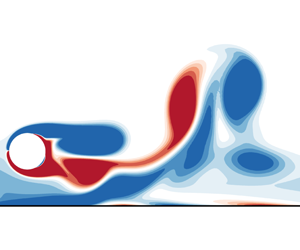Article contents
Modes of synchronisation around a near-wall oscillating cylinder in streamwise directions
Published online by Cambridge University Press: 17 April 2020
Abstract

Two-dimensional direct numerical simulations of a cylinder undergoing forced streamwise oscillations in steady approaching flow are conducted over ranges of oscillation amplitude, oscillation frequency and gap distance between the cylinder and the wall at a Reynolds number of 175. The flow characteristics are found to be strongly affected by the gap distance, compared to those observed around an isolated cylinder (Tang et al., J. Fluid Mech., vol. 832, 2017, pp. 146–169). The synchronisation modes are mapped out in the parameter ranges. The existence of the plane wall leads to an increased chance of occurrence of high-order modes with the denominator being an odd number. Two new flow phenomena, namely the period doubling and transition to quasi-periodic states through cascade of period doubling within the primary synchronisation region, are observed. The interaction of the plane-wall boundary layer with vortices shed from the cylinder and the asymmetry of the flow through the gap and around the top side of the cylinder are identified as the primary physical mechanisms responsible for the observed behaviours. The influence of velocity gradient in the plane-wall boundary layer on the two new phenomena is quantified through a numerical test involving linear shear flow around an isolated cylinder. The period-doubling phenomenon occurs only when the velocity gradient is larger than a critical value. The results obtained through three-dimensional simulations suggest that the synchronisation modes identified through two-dimensional simulations are not significantly affected by the three-dimensionality of the flow over the parameter ranges covered in the present study.
JFM classification
Information
- Type
- JFM Papers
- Information
- Copyright
- © The Author(s), 2020. Published by Cambridge University Press
References
- 6
- Cited by

